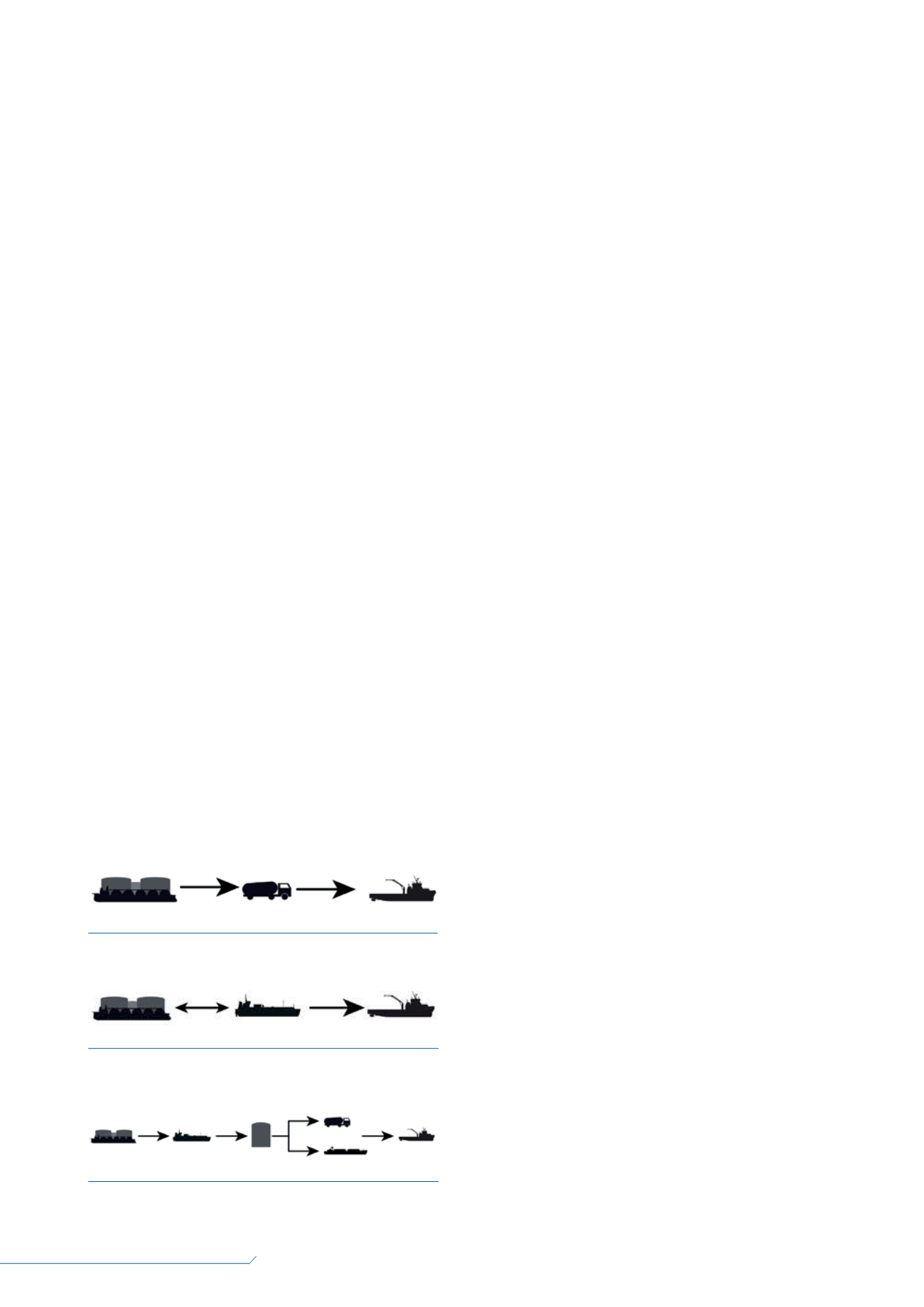
66
LNG
INDUSTRY
APRIL
2016
protection, and authorisation for bunker operators and their
equipment.
Presently, one of the key topics in LNG bunkering, and one of
crucial importance to any ship owner looking tomake the switch
to LNG fuel, is simultaneous operations – the loading or unloading
of cargo during bunkering operations.
Based on the risk assessment, bunkering LNG from the
quayside or from a bunker vessel while conducting cargo
operations seems possible for those ports and terminals situated
outside of urban areas, where the severe casualty threshold, for
which strict mitigationmeasures need to be taken, is not reached.
LNG bunker fuel market
evaluation
In 2015, LNGwas being used as a bunker fuel by fewer than
80 vessels, which weremainly located in Scandinavian countries.
At the time of writing, an additional 80 gas-fuelled ships were
on order andmany more are likely to be ordered in the coming
years (especially after the worldwide ban on high sulfur fuel oil,
which will come into force in either 2020 or 2025, depending on a
decision by the International Maritime Organization).
These vessels will generate demand for LNG in Europe that
needs to be anticipated by all of the parties involved, especially
the port authorities, who will be responsible for organising and
promoting this activity at a local level.
Themethodology used to evaluate the LNG bunker market is
comprised of the following steps:
Analysis of the local bunker market using past bunker fuel sale
records and harbour traffic predictions.
Estimation of bunker fuel market volume for the coming years
(in terms of energy content).
Definition of different scenarios for themarine fuel mix likely
to be used onboard in the coming years.
Application of these scenarios to the bunker market under
assessment.
Effect of LNG demand fromother clients (industry, electric
production).
Twomain scenarios were identified to assess the evolution of
marine bunker fuel mixes.
Scenario 1: LNG as a marginal marine fuel
In this scenario:
LNG remains a more expensive energy source than heavy fuel
oil (HFO).
Offshore scrubbing technology enabling the use of HFO
as fuel becomes viable and solutions are found to the
operational problems.
The likely consequences of this hypothesis include the
following:
HFO remains themost popular marine fuel after 2020
because exhaust gas treatments have improved.
Most ship owners take a ‘wait and see’ approach, running
their ships onmarine gas oil (MGO), while waiting for the
worldwide low sulfur cap to come into force and then shifting
to HFO and a scrubber.
LNG as a marine fuel is strictly limited to specific projects, such
as highly captivemarkets within SECAs with regular port of
calls (typically ferries, cruise ships, RoRo vessels and harbour
services).
Scenario 2: the substitution of HFO by LNG
Under this alternative scenario:
LNG becomes a cheaper source of energy than either HFOor
MGO.
A European and worldwide LNG bunkering network is
developed.
Scrubbing technology continues to face recurrent problems,
such as high operational costs, reliability, waste disposal
problems, etc.
The likely consequences of this hypothesis include the
following:
LNG replaces HFOglobally.
The first vessels to change over to LNG are those operating
within regular markets, especially containerships sailing
between Europe and Asia.
A new industrial demand for LNG emerges to supplement the
LNG bunker market (mainly consisting of a shift from fuel oil
and LPG to LNG).
Logistic schemes, facts and
figures
The use of LNG as bunker fuel implies a dedicated logistic
scheme. As none of the Seine river valley harbours are LNG
import terminals, any future plans must include both supply and
distributionmeans.
Depending on the demand for LNG in this area, different
resources may be used, including the following:
Bunker trucks: cheap to buy and to operate, bunker trucks
are currently themost common LNG bunkeringmethod.
However, with a limited capacity of approximately 55m
3
,
they can only be a solution in a non-maturemarket. Based
on a daily journey from the nearest LNG terminal (Dunkirk,
France), each LNG bunker truck represents an LNG flow of
approximately 1000m
3
/month. The bunker truck scheme is
described in Figure 4.
Small scale vessels: with a typical capacity of under
40 000m
3
, these vessels are dedicated to supplying LNG
Figure 4.
Logistic scheme number one – LNG supply by truck.
Figure 5.
Logistic scheme number two – LNG supply by LNG
bunker vessel.
Figure 6.
Logistic scheme number three – supply by LNG
small scale carrier and bunkering by truck or vessel.


